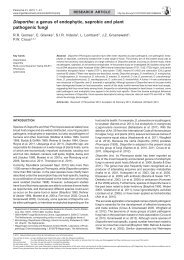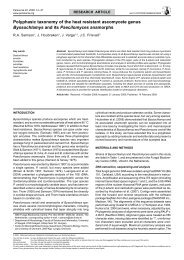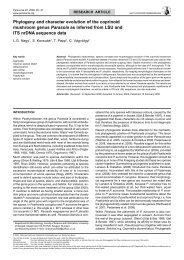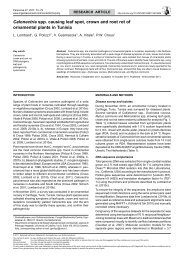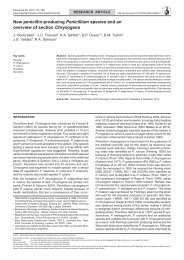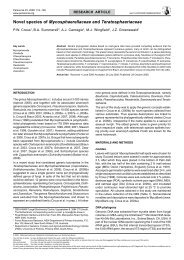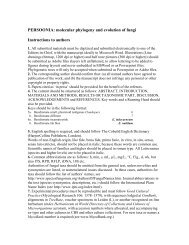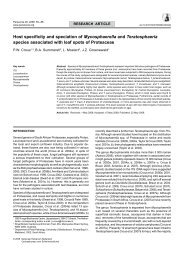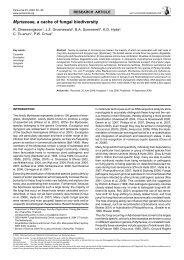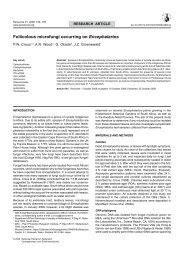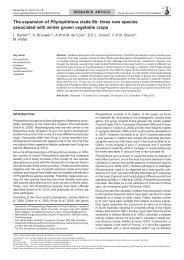Phylogeny and taxonomy of obscure genera of microfungi - Persoonia
Phylogeny and taxonomy of obscure genera of microfungi - Persoonia
Phylogeny and taxonomy of obscure genera of microfungi - Persoonia
Create successful ePaper yourself
Turn your PDF publications into a flip-book with our unique Google optimized e-Paper software.
P.W. Crous et al.: Obscure <strong>genera</strong> <strong>of</strong> micr<strong>of</strong>ungi<br />
143<br />
Fig. 1 (cont.)<br />
3 Lauriomyces bellulus CBS 517.93<br />
IC<br />
4 100 Lauriomyces heliocephalus CBS 112054<br />
Potebniamyces pyri DQ470949<br />
RHY<br />
5 Crinula caliciiformis AY544680<br />
HEL (1)<br />
100<br />
Holwaya mucida DQ257356<br />
Leuconeurospora pulcherrima AF096193<br />
61 6<br />
IC<br />
Pseudeurotium zonatum AF096198<br />
933<br />
PSE<br />
Pseudeurotium zonatum DQ470988<br />
3 97<br />
Amorphotheca resinae EU040230<br />
Amorphotheca resinae EU040231<br />
AMO<br />
100 Hyalodendriella betulae EU040232<br />
IC<br />
Phialea strobilina EF596821<br />
5 7 100 Haplographium catenatum CBS 482.67<br />
Haplographium catenatum CBS 196.73<br />
HYA (1)<br />
Haplographium catenatum CBS 739.68<br />
3 Clathrosporium intricatum AY616235<br />
66 Hydrocina chaetocladia AY789412<br />
Rhyzoscyphus ericae AM887699<br />
IC<br />
HEL (2)<br />
89<br />
Protoventuria alpina EU035444<br />
Thedgonia ligustrina CPC 10019<br />
100<br />
Thedgonia ligustrina EU040242<br />
Thedgonia ligustrina CPC 10861 IC<br />
Thedgonia ligustrina CPC 14754<br />
3<br />
Thedgonia ligustrina CPC 10530<br />
Trichoconis echinophila EU107315<br />
91 Trematosphaeria pertusa DQ678072<br />
10 changes<br />
8<br />
100<br />
100<br />
88<br />
Aposphaeria populina EU754130<br />
Herpotrichia juniperi DQ678080<br />
Wettsteinina macrotheca AY849969<br />
Seifertia azaleae EU030276<br />
Mycopappis aceris CPC 14379<br />
70<br />
Xenostigmina zilleri CBS 115685<br />
Xenostigmina zilleri CBS 115686<br />
Xenostigmina zilleri CPC 14376<br />
100<br />
Dictyosporium toruloides DQ018104<br />
Dictyosporium strelitziae CPC 15359<br />
Dictyosporium elegans DQ018100<br />
Dictyosporium alatum DQ018101<br />
91<br />
Pseudodiplodia sp. EU754201<br />
Coniothyrium concentricum EU754152<br />
Leptospora rubella DQ195792<br />
Phaeosphaeriopsis musae DQ885894<br />
HYA (2)<br />
MEL<br />
LOP<br />
PLE (1)<br />
60<br />
LEP<br />
IC<br />
PHA<br />
Phaeosphaeria nodorum EF590318<br />
Edenia gomezpompae CPC 15689<br />
Chalastospora gossypii CBS 112844<br />
94 Chalastospora gossypii DQ008142<br />
Chalastospora gossypii CBS 114810<br />
Chalastospora gossypii CBS 114005<br />
Chalastospora gossypii CBS 900.87<br />
Chalastospora gossypii var. polymorpha AY251080<br />
Chalastospora gossypii AY251081<br />
100 Chalastospora gossypii AY251079<br />
Chalastospora gossypii CPC 3685<br />
Chalastospora gossypii CPC 3680<br />
Chalastospora obclavata CBS 124120<br />
Chalastospora gossypii CPC 3690<br />
Chalastospora gossypii CPC 15567<br />
Chalastospora gossypii CBS 114809<br />
Chalastospora cetera CBS 121340<br />
64<br />
Chalastospora ellipsoidea CBS 121331<br />
IC<br />
PLE (2)<br />
<strong>and</strong> a series <strong>of</strong> branches, giving rise to chains <strong>of</strong> hyaline conidia<br />
via sympodial conidiogenesis. Brycekendrickomyces is morphologically<br />
similar to Lauriomyces, which in turn resembles<br />
Haplographium. The genus Haplographium is based on H. delicatum.<br />
Its confused history is discussed in detail by Zucconi<br />
& Pagano (1993). Haplographium delicatum was originally<br />
described by Berkeley & Broome as having conidia in chains<br />
(Mason 1933), which Saccardo (1886) also reported for the<br />
type species. Hughes (1958) noted that Stilbum catenatum<br />
was an older name for H. delicatum, which led Holubová-Jechová<br />
(1973) to place this species in Haplographium, while<br />
Castañeda & Kendrick (1990) placed it in Lauriomyces. If<br />
Haplographium <strong>and</strong> Lauriomyces are synonymous, the older<br />
name, Haplographium, would have preference. However, as<br />
shown here, ‘Lauriomyces’ catenatus is not congeneric with<br />
other species <strong>of</strong> Lauriomyces, such as L. heliocephalus (Rao<br />
& de Hoog 1986, Castañeda & Kendrick 1990) <strong>and</strong> L. bellulus<br />
(Crous & Wingfield 1994), suggesting that the two <strong>genera</strong> are<br />
distinct, <strong>and</strong> that the name Haplographium catenatum should<br />
be resurrected. Data from this study, furthermore, suggest that<br />
the strains <strong>of</strong> H. catenatum included here, probably represent<br />
a species complex.<br />
Brycekendrickomyces differs from Haplographium <strong>and</strong> Lauriomyces<br />
by the absence <strong>of</strong> an intricate conidiophore branching<br />
system, <strong>and</strong> in having conidia produced in slimy heads rather<br />
than in chains. Furthermore, it is not phylogenetically related<br />
to species <strong>of</strong> Lauriomyces or Haplographium presently known<br />
from culture (Fig. 1). Brycekendrickomyces is somewhat similar<br />
to Argopericonia (Sutton & Pascoe 1987), although the latter<br />
fungus produces hyaline, apical conidiogenous heads, <strong>and</strong> it<br />
has ellipsoidal, single to short catenate conidia, each with a<br />
prominent, globose guttule.



